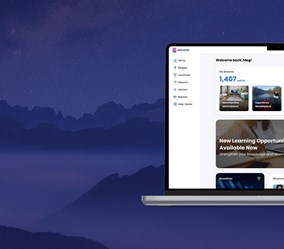Deciding on the Right Incentive Structure for Sales
When you have a finite budget to work with, it’s difficult to choose a sales incentive structure that will work for your company.
Scroll Down
Harness the power of your sales team with incentives that inspire.
Open-end budget structures historically produce much stronger results.
Why?
Because everyone can earn awards based solely on how they perform, and if they have a personal objective, it is based on their own past performance. Participants feel in control of their own destiny (i.e. they earn if they succeed and rewards go up in proportion to how strongly they succeed).
It’s all up to them! The motivation is just as strong on the last day of the program as it is on the first!
Advantages of Open-End Incentive Structures
- Strongest motivation to participants and thus best results.
- Awards can be set at a fixed percentage of sales (or incremental sales only) generated.
- Builds strong performance behaviours into participants, so sales continue at the higher rates for some time after the reward period.
- Improved morale. Award earners feel gratitude and loyalty to the sponsor, and even if they didn’t earn, they know it was their own fault. In closed-end “contests” with many more losers than winners, bad feelings are often created.
- Improved product knowledge and skills. Motivated people tend to want to learn all they can to help them earn the awards. These skills will carry forward after the program ends. Link award program periods with periods when special training is being offered to take advantage of this factor (learning and engagement drive performance).
Disadvantages of Open-End Incentive Structures
It is not possible to assure that the “planned” budget won’t be exceeded. If the actual program results exceed the anticipated or expected results, you must continue to pay out awards at the percentage(s) stated in the program.
Well-designed programs ensure that the return on investment is there, and while budgets require ongoing managing it’s a “happy problem” to have. That is, we are usually happy to continue paying out at the agreed rate in order to reap the extra profits on the incremental sales.
Closed-End Budget Incentive Structures
- A fixed budget — a specified number of dollars and no more — usually pre-supposes a contest of some kind. Sales contests have a small number of winners and a large number of “losers.” Closed-end programs are not bad; they simply are not as effective as open-end structures. Sometimes, however, they are unavoidable. For instance, your corporate budgeting culture only permits fixed budgets or when the amount available simply isn’t enough to support an “all can earn” structure.
- Closed-end structures usually are budgeted to reward about 30 percent to 40 percent of the participants. If a closed-end structure rewards 20 percent or less of program participants, most, if not all, of the awards will likely go to the top 20 percent of participants depending on the rules structure. Most of the remaining 80 percent will quickly realize this and will not be motivated by the incentive program.
If a closed-end structure rewards over 40 percent of program participants, the client will likely not have a sufficient budget. If the client has a sufficient budget to reward more than half of program participants, they would likely be better off with an open-end structure which tends to generate better results. That said; try to stretch the available budget to cover as large a portion of the total audience as possible.
For example purposes only, if you have a budget of about $50,000 for 500 participants, don’t blow the entire budget on a $10,000 trip to Europe for the Top 5 performers, leaving the other 495 participants with nothing. Both you and the majority of participants would be better off having step-up awards. Say, for example:
- Top 10 performers earn $1,000 in award points
- Next 20 performers earn $600 in award points
- Next 40 performers earn $400 in award points
- Next 130 performers earn $100 in award points
Since there will be a total of 200 winners (40 percent) out of 500 participants, most people will feel they have a chance to win and, as a result, will participate.
Advantages of Closed-End Incentive Structures
- Award budgets are set; there is no risk of over-spending available budgets.
- If a closed-end structure can reward 30-40 percent of program participants, this can be a strong motivator and produce good results.
- Builds solid performance based behaviours into participants, so sales may continue at higher rates for some time after the reward period.
- Depending on the program design and structure used, generally the Top 20 percent and some of the middle 60 percent will earn awards, so it engages the best participants.
Disadvantages of Closed-End Incentive Structures
Obviously, the biggest disadvantage with closed-end structures is that you cannot award each and every eligible activity. The smaller the budget, the less frequent you can recognize eligible activities thereby decreasing the program’s effectiveness. Participants may feel that the effort isn’t worth the chance for an award, that they don’t have a realistic chance to earn an award, or that the program is potentially unfair. Finally, some closed-end structures also pose additional challenges such as legal considerations (e.g. sweepstakes).
Sales Incentives Made Easy
Take control of your sales incentive structure and let your employees feel in control of their own destiny with sales incentives from BI WORLDWIDE Canada.
With these 12 proven open and closed-ended incentive structures, you’ll be able to run an unlimited variety of contests and employee incentives for your sales teams:
- Do This Get That: Simple sales incentive structure where participants are rewarded each time they meet specific criteria.
- Plateau/Tiered: Simple incentive structure where 3-5 levels are predetermined; participants are rewarded based on the level they achieve at program’s end.
- Accelerator: A Do This Get That sales incentive structure where payouts increase (accelerate) as key milestone levels are met.
- Balanced Mix: A Do This Get That structure where participants must sell multiple products and/or perform a variety of activities to earn.
- Break The Bank: Participants earn a portion of a prize pool on a first come-first earned basis, based upon defined sales/activities; when the pool of rewards runs out, the promotion is over.
- Sweepstakes: A Do This Get That structure with a chance to earn a reward (probabilistic).
- Stack Ranking: Eligible participants are ranked on the defined program metric(s) at one or more pre-set times; the number of earners is determined at the start of the program.
- Breakthrough: Blends two popular rules structures, Do This Get That and Plateau/Tiered, where participants earn cumulative awards as key performance targets are hit.
- GoalQuest: A proven pay for performance, all-or-nothing structure where eligible participants self-select a goal at the start of the program; the higher the goal level, the greater the potential reward.
- Double Down™: Empowering goal-based structure that uses three distinct measurement periods, where participants have the opportunity to increase their reward earnings significantly by “Doubling Down” or going “All In” as the program progresses.
- ChallengePoint™: Blends the personal goal setting of GoalQuest with a base earnings component, thus allowing participants to earn some reward, even if they do not hit their chosen goal.
- Learn & Earn: Simple activity-based structure that rewards participants for successful training completion.
Let’s create a sales incentive structure that aligns with your business goals.
























